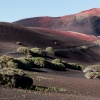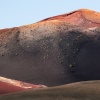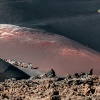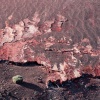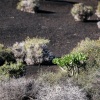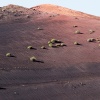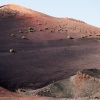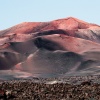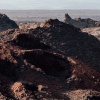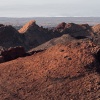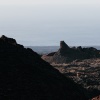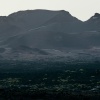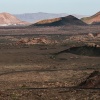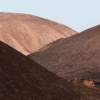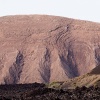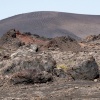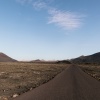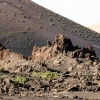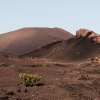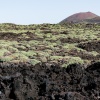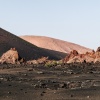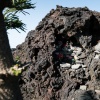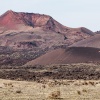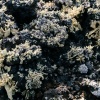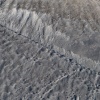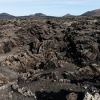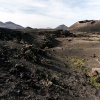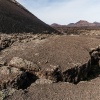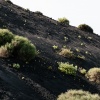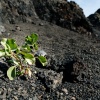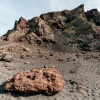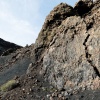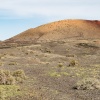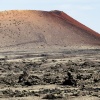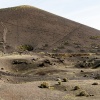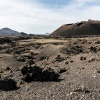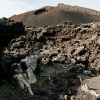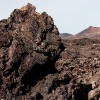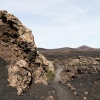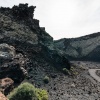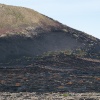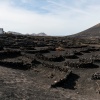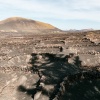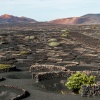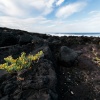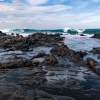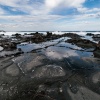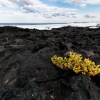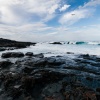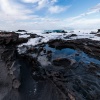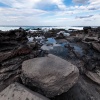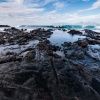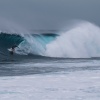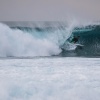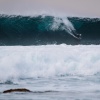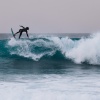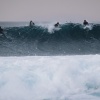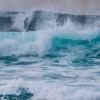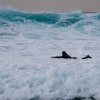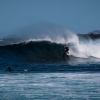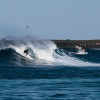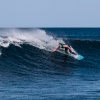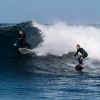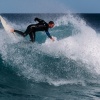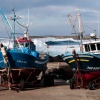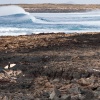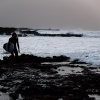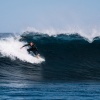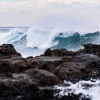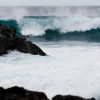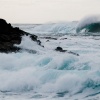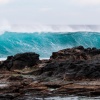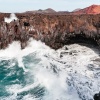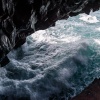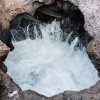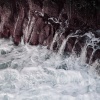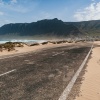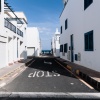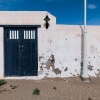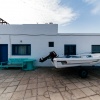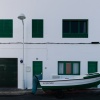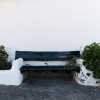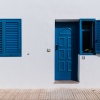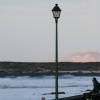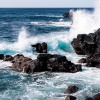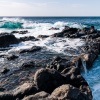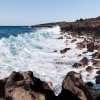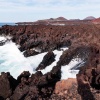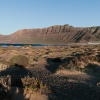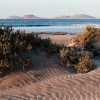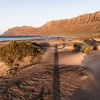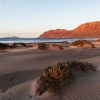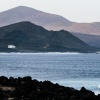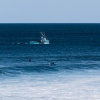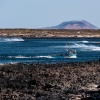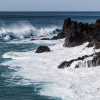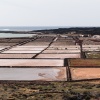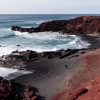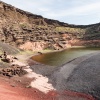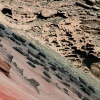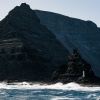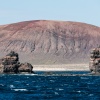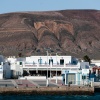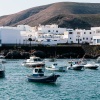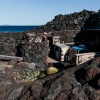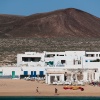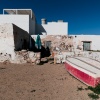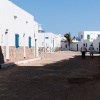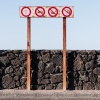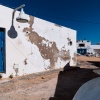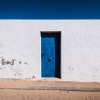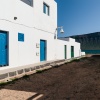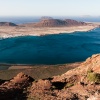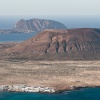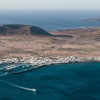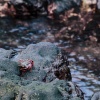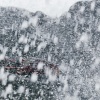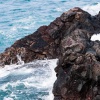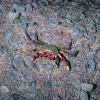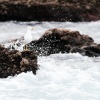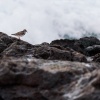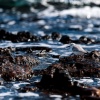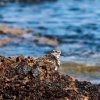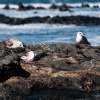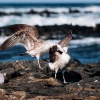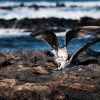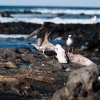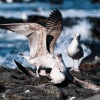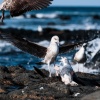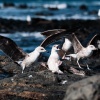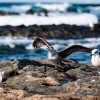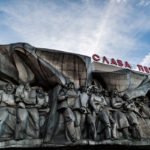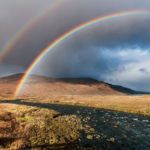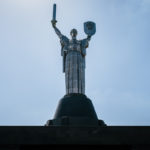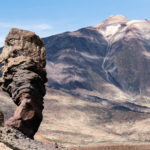Surfer paradise at Timanfaya volcano – Out and about Lanzarote
On Lanzarote and neighbouring La Graciosa the volcanic origin of the Canary Islands is most apparent and youngest. In 1730 a gigantic eruption started, tore the Earth open and created within 6 years only an exceptionally extraterrestrial appearing landscape. Lanzarote’s way of growing wine in the lava desert is unique worldwide and complements fish and seafood like hand and glove when sitting at the Atlantic shore watching some first-class surfers taking the waves.
Lanzarote – Spain’s Hothead in Atlantic Ocean
In the year 1730, on Septembre 1st, between 21 and 22 o’clock the Earth opened up near Timanfaya, being only two travel hours away from Yaiza. Within one night only a tremendous mountain emerged shooting flames into the sky from its peak. The fire burnt 19 days long and only few days later another maw appeared…” That’s how the portrayal of Andrés Lorenzo Curbelo starts, the former pastor of Yaiza.
Back in those early day Andrés had no idea what exactly his Lord set into operation and that everything will last some remarkable 6 years. In the end of one of the biggest eruptions humans have every witnessed, about 167 km² of Lanzarote were covered with lava having an epic volume of 8 million cubic kilometres having pushed from interior Earth to its surface. The neighbour and one of the Canary main islands Tenerife also demonstrates the immense creative capability of volcanism.
Lanzarote’s youngest eruption dates back to the year 1824, when the ignition key of the Canarian volcanic engine got turned again as on July 31st Volcán de Clérigo Duarte appeared creating a 14 kilometres measuring eruption fissure that pumped its lava mass not only flowing to Punte del Cochino and the sea but also towards the small village of Mancha Blanca. It’s a true miracle that the wall of hot steaming molten rocks stopped and reprieved the small settlement near Tinajo – where the national park administration is based – from complete destruction.
“Even today the volcanic stove is pretty much alive” says one of the ever grinning tourist guides as visitors gather around a hole in the ground near El Diablo restaurant. Up there, at Hilario scenic outpost, and of course from space one can see the cinder cones of Timanfaya eruption and why experts call it fissure eruption. Throwing a bunch of paper and brushwood into the burrow, the tourist guide demonstrates how quickly his highly combustible melange gets consumed by volcani flames as Earth right under the tourists feet is everything but cold.
Wine in the Desert
It’s not the lava’s fault that Lanzarote is sparely vegetated. Rather strong and ever blowing dry winds coming from Africa are the reason as they are nagging at the offshoots’ first minutes of life. Also Lanzarote is the driest among the Canary Island. Hence how the hell is it possible to grow wine and fruits under those circumstances? The wine estates of La Geria give an insight.
Lanzarote’s Malvasia grape plants grow wind-protected in funnels built of volcanic ash. The porous ash helps to catch air moist and lead that humidity down to the bottom where the heart of the plant, its root, gets fed from water being stopped from seeping away by a patch of clay.
It’s really amazing what bright ideas humans can have. And that’s how the best growing pioneer plants of Lanzarote’s volcano area are not the ones being put into the race by Mother Nature but by humans. Lanzarote’s Malvasia vines have a subtle fruity character showing hints of apple, pear and gooseberry. They are mineral and fresh with a crisp but potent acidity and rarely go beyond the 13% landmark when it comes to alcohol.
Growing wine shows that Canarios don’t knuckle under to the island’s volcanic origin but support and use its pretty fertile personality to create something new. Another example is Volcán El Cuervo, what they are using as a venue for concerts of all kinds of music. In the very vicinity of that cinder cone one can find plenty of shiny olivine stones. But also the wind over here is merciless and makes gem searchers quickly become hypothermic while whipping their faces with volcanic ash.
Surfing at razor-sharp Coasts
Another of Lanzarote’s characteristics are its rugged coasts. One literally feels the same pain when watching the surfers walking barefoot over razor-sharp lava rocks to reach the desired open water. Those moments appear a bit like a penguin’s life, as the surfers literally live up once the spiky path is survived and they can ride waves being up to 2.50 metres high.
Some of the surfers in the waves off the coast of La Santa are world class. It’s pure delectation to watch them being one with their board when riding wave after wave and delivering stunts originating from pure joy of doing what they are doing. Usually one has to pay admission to watch such artistry. Of course the boys and girls kick things up a notch when a pro photographer watches them, and who to boot has no problem to give away those shots ;-)
Another optical delectation are the waves itself. Waves are energy in the shape of rolling water and some of them travel thousands of kilometres through the ocean to fall to rocky death at the shore of Lanzarote. Being backlit by sun then nature pushes all colour buttons ranging from deep blue over turquoise to gleaming white.
The washing ocean surges through every little crack in the lava rocks making this place being very hard for plants to settle down. Some of them make it to survive though and puncture the black stony curtain greenish. The washing sea leaves salt water puddles behind. They are an excellent hideaway for octopus and cuttlefish, know the locals and walk hunting through the coastal rocks.
Having a share of bit more than 10% only, that is 26 kilometres in the 213 kilometres measuring coast line, real beaches with sand or shingle and providing normal access to the sea are a bit rare on Lanzarote. Except the beach at Famara, where one inevitably becomes victim of the omnipresent wind that gets quite a boost over there due to Risco de Famara, a huge ridge turning regular wind into a down draught. The stirred up air transports sand deep into the village and deep into kitchens as well as living rooms. Not to mention the heavy sea being caused by wind and leading to often ban on swimming.
Mountain crest with sea view
In general the powerful surge around Canary Islands is nothing one should underestimate as at some places the waves easily drag swimmers outwards onto the open sea. Most apparent that force and danger becomes at Los Hervideros, the “sparkling holes”, a small cove where wave after wave smashes non-stop and without braking against the rugged lava. Over the course of time the surging water cut through the rocks and made it sort of being accessible for humans.
At the north coast of Lanzarote another explorable island can be found, that is La Graciosa. Being inhabited by only some 700 people it is the smallest island of the Canary Islands. When viewed from Lanzarote’s Mirador del Rio then one can quickly see that also La Graciosa is a volcanic island. In the winter months the wind over there is even stronger and makes airborne sand being an omnipresent companion when living or staying on La Graciosa.
From the fishermen village of Orzola ferries start regularly to the island of Chinijo Archipelago taking (day) visitors onto La Graciosa where in Caleta del Sebo a bunch of restaurants already await the tourists. They get their water through a pipeline in the ocean and have a like-minded monopolistic attitude as they are aware of being the only ones to serve a continual flow of visitors that can’t escape the island due to a very long ferry lunch break. Restaurants in La Santa or Famara are way better in terms of quality and food.
Speaking of food… At many places Lanzarote offers wonderfully tasting octopus grilled to perfection. The cuttlefish’s perfect companions are papas arrugadas con mojo, the small potatoes being typical to Canary Islands and being prepared in sea salty water. They come with Mojo Picon or Mojo Verde and are a second to none delicacy and must-have tried when visiting the Canaries. Some of the best food I had in La Santa’s El Barquillo.
When disregarding supermarkets and their pretty Germanised range of goods, then the ocean is fortunately still number one when it comes to Canarian way of sustenance. Supplying the islands with octopus and seafood is the job of grumpy seamen whose little boats cut through stormy waves every day anew.
What humans leave behind from their hunt in the ocean quickly becomes an object of seagull desire. Swearing like troopers they don’t hesitate to kick off a food jealousy battle among conspecifics. The wonderfully coloured crabs slumbering at the waterfront are not concerned in the slightest about the seabirds, as they stoically keep on enjoying their sunbath on the Canary Atlantic sun.
